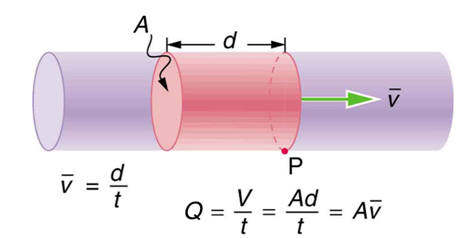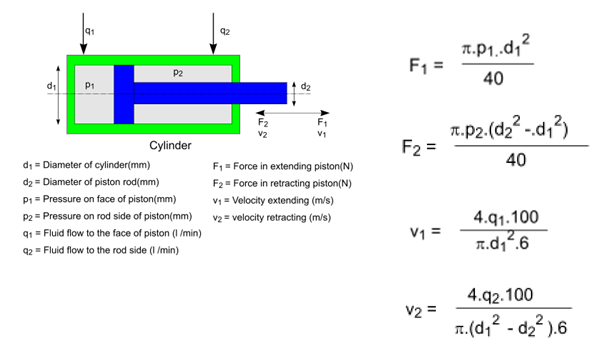
Due to the fact that we’re discussing cylinders, we’ll need to access some key equations in order to determine Force and Velocity. Take a look at the equations and diagram below:

Let’s take a look at a practical example. What flow rate in gallons per minute (gpm) would be required to power a hydraulic cylinder with a 4 inch bore x 2 inch rod x 20 inch stroke operating at a rate of 10 cycles per minute? First, we know that in order for the cylinder to cycle at a rate of 10 cpm, a cycle could not last longer than six seconds (60 sec/min / 10 cpm = 6 sec)
The first calculation we need to make for this problem would be the Volume required to extend the cylinder. Volume = Area X Stroke. In this example, the Area is calculated with π(r)², and we know the radius is 2 inches. This means the area equals 12.57 sq-in. So 12.57 sq-in x 20 in = 251.4 cu-in.
Next, we need to calculate the volume required to retract the cylinder V = A x S. The area is found in this example by subtracting the bore area from the rod area. In this example that would be π(2)² - π(1)². So V = 9.43 sq-in x 20. This means that V = 188.6 cu-in.
Next, we add these two volumes together: 251.4 cu-in + 188.6 cu-in. This totals out to 440 cu-in. Our next step is the multiply this volume by our cycle time which we’ve determined to be 10 cpm. When we do this, we see that we have a flow rate of 4400 cu-in/min. In order to express this in terms of gallon per minute, we divide this number by 231 cu-in/gal. When we do this we find that 4400 cu-in/min divided by 231 cu-in/gal equals 19.05 gpm.
It’s also important to understand the role that Mechanical Advantage plays in the discussion. Mechanical Advantage is a measure of force amplification achieved by using a tool, mechanical device or machine system. We can define mechanical Advantage in equation form by expressing it as the Total Rod Length divided by the Supported Rod Length -- MA = TRL/SRL.
Additionally the reaction force acting against the rod bearing is the mechanical advantage times the side force acting against the end of the rod or RF = MA x SL.
So knowing these equations, if a hydraulic cylinder has a 20 inch stroke, is extended 8 inches and has a 90 lb side load acting against the end of the rod, what would be the reaction force acting against the rod bushing?
First we need to determine the Supported Rod Length (SRL). We do this by subtracting the 8 inch extension from the 20 inch stroke, 20-8 = 12. Next, we plug this into our equation MA = TRL/SRL = 20/12 = 1.67. Next, we plug in our numbers to our equation RF = MA x SL. RF = 1.67 x 90. This comes out to 150 lbs.
We’ve now gone over a few more basics in fluid power: velocity, flow rate and reaction force. Be sure to continue checking out our series where we discuss Torque and Speed Ratio.
Fluid Power - Introduction to Pressure: The Basics